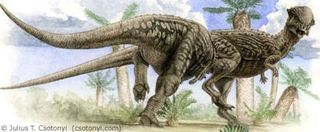Teenage Dinosaurs Might Have Butted Heads

Dome-headed dinosaurs might have passed through a combative teenage stage in which they butted heads in violent clashes.
New research reveals the skulls of a group of these young dinosaurs would have compressed and rebounded after a head ram, preventing a brain bashing. The study, to be announced today and detailed in the journal Palaeontologia Electronica, sheds light on a debate over head-butting in so-called pachycephalosaurs, or thick-headed reptiles.
This group of relatively small dinosaurs lived from about 80 million to 65 million years ago during the Late Cretaceous Period mainly in Asia and North America, where they likely grazed on ferns and some flowering plants.
Their claim to fame would have to be the dinosaurs' thick bony caps. The ornate head gear ranged from Prenocephale's sloping skull, which resembled a sleek bike helmet, to the lengthy horns that topped the skull of Stygimoloch or the more delicate cap worn by Stegoceras, outlined with a fringe of bony knobs.
With such hard heads, the dinosaurs may have butted one another like bighorn sheep, over mates, food or territory, according to researchers Eric Snively of the University of Alberta and Andrew Cox of Villanova University.
Or the flashy noggins may have served as mate-bait or for visual communication, said Mark Goodwin of the University of California-Berkeley's Museum of Paleontology.
"I would still argue that there is no evidence to support head-butting in pachycephalosaurs," said Goodwin, who was not involved in the current study.
Sign up for the Live Science daily newsletter now
Get the world’s most fascinating discoveries delivered straight to your inbox.
Goodwin's research suggests protective features of pachycephalosaur skulls are just temporary and part of maturing. "It's a product of fast-growing bone that we hypothesize is used for display and visual communication," he said.
Spectator sport?
To conjure the head-butting scenario, Snively and Cox developed computer models of the skulls of Homalocephale colathoceros and Pachycephalosaurus wyomingensis as well as a skull of a Pachycephalosaurine sub-adult. They based the models on photographs and reconstructions of the skulls.
They simulated the animals moving with closing speeds of both 6.7 mph and 15 mph (3 meters per second and 6.7 m/s), the latter being the maximum ramming speed given the likely hip heights and limb proportions of pachycephalosaurs. The resulting smash-ups provided information on the amount of force, how that stress was distributed along the skulls and ultimately the post-ramming state of the skulls.
The resulting force would rattle any football player today, but in the dino world, human linebackers would have packed a wimpy punch. "The highest forces we got for a large pachycephalosaur were about 14,000 Newtons, or about as much as T. rex would exert with one of its back teeth," Snively said.
Past research by Snively found that Tyrannosaurus rex had fused arch-like nasal bones that allowed the paleo-bully to chomp down on prey with the force needed to lift a semi-trailer without busting up its own skull.
The researchers found that the skull of Homalocephale would have handled most scenarios, though during high-speed impacts, its skull couldn't fully dissipate the stress in the region in front of the brain.
"The stresses in big adults were usually far below those that would break the bone," Snively said. However, he noted, research by Goodwin and Jack Horner of Montana State University's Museum of the Rockies has shown that an adult pachycephalosaur would've had almost no blood vessels embedded in its dome.
"We don't know how it could heal internally. Any sort of damage would be bad news," Snively added.
The sub-adult skull was much more resilient. Research has shown the skulls of younger pachycephalosaurs were equipped with radiating structures that compressed when rammed. These structures would have cushioned the blow during head-to-head combat.
"When they were older teenagers or young adults, that's when they would be best at head-butting," Snively told LiveScience.
Butting behavior
Snively cautions, however, that just because the thick-headed reptiles could ram heads does not mean they did so.
Goodwin echoes that caution. He and Horner published a study in a 2004 issue of the journal Paleobiology suggesting the dinosaurs flaunted their head caps to woo mates or for visual communication.
Their research showed the radiating structures in younger pachycephalosaur skulls represented a stage of the dinosaur's dome-skull development.
"A lot of the structures that are ascribed to give these animals a biomechanical advantage are in fact a product of fast-growing bone," Goodwin said during a telephone interview. He added that once pachycephalosaurs reach adulthood, a time when head-butting behaviors would be most likely, the structures are absent.
"So if the structures that give an animal a biomechanical advantage are absent, then they likely didn't engage in that type of hypothesized behavior to begin with," Goodwin said.
Currently, Snively and colleagues are examining the skulls of pachycephalosaurs for any evidence of head-butting injuries. They predict injuries will occur more often in the sub-adults. Goodwin said that he and Horner have yet to observe such injuries in pachycephalosaur skulls.
Snively's current study was funded by Villanova University, the Jurassic Foundation, University of Calgary Research Services, and the National Sciences and Engineering Research Council of Canada.
- Vote: Avian Ancestors: Dinosaurs That Learned to Fly
- Image Gallery: Dinosaur Art
- Dinosaur Quiz

Jeanna served as editor-in-chief of Live Science. Previously, she was an assistant editor at Scholastic's Science World magazine. Jeanna has an English degree from Salisbury University, a master's degree in biogeochemistry and environmental sciences from the University of Maryland, and a graduate science journalism degree from New York University. She has worked as a biologist in Florida, where she monitored wetlands and did field surveys for endangered species. She also received an ocean sciences journalism fellowship from Woods Hole Oceanographic Institution.
Most Popular

